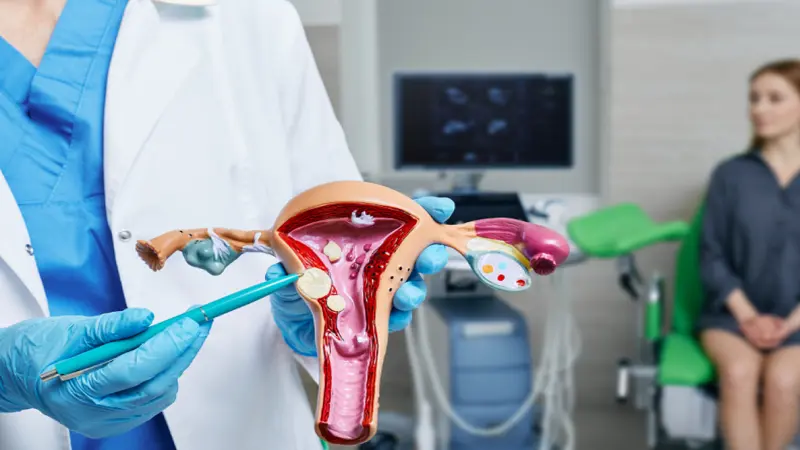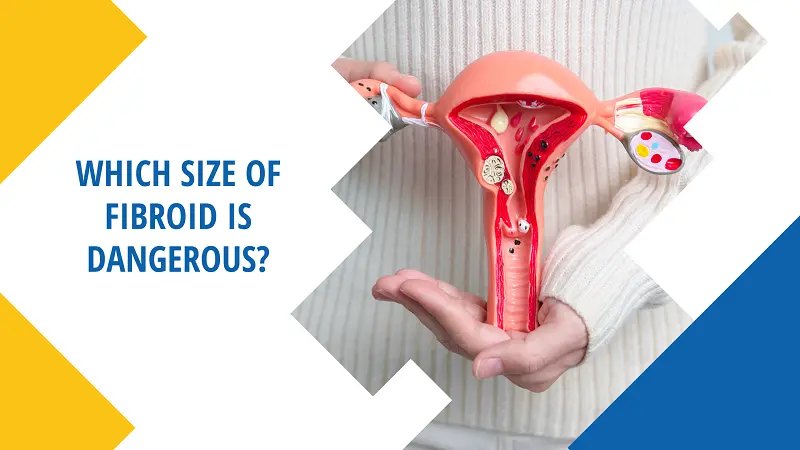Fibroids, or uterine leiomyomas, are common growths in the uterus. These non-cancerous tumors vary, from as small as a pea to as large as a melon. While many fibroids do not cause symptoms, certain sizes can lead to significant health issues. Understanding which size of fibroid is dangerous is essential for managing and treating symptoms effectively. This article explores the types, causes, symptoms, and complications associated with fibroids, focusing on how size impacts health.
What Are Fibroids?
Fibroids are benign tumors made of muscle and connective tissue. They grow in or on the uterus. These tumors can appear as single growths or multiple masses. Many women develop fibroids at some point, especially during their reproductive years.
Most fibroids are harmless. They often remain small and unnoticed. However, certain fibroids can grow large enough to cause severe health problems. Learning which size of fibroid is dangerous is crucial in understanding the risk they may pose.
Types of Fibroids
Fibroids are classified based on their location within the uterus:
- Intramural Fibroids: These are the most common type. They develop within the muscular wall of the uterus. Large intramural fibroids may enlarge the uterus and distort its shape.
- Subserosal Fibroids: These grow on the outer surface of the uterus. They can press on surrounding organs as they increase in size, leading to discomfort.
- Submucosal Fibroids: These grow into the inner cavity of the uterus. They can interfere with fertility and menstrual cycles.
- Pedunculated Fibroids: These fibroids are attached to the uterus by a stalk. Both subserosal and submucosal fibroids can be pedunculated, increasing the risk of torsion (twisting), which can cause severe pain.
Understanding which type and size of fibroid is dangerous can help in assessing potential health risks.
Factors Affecting the Size of Fibroids
Fibroids can range from less than 1 centimeter to over 20 centimeters. Many factors can influence fibroid growth, including:
- Hormones: Estrogen and progesterone stimulate fibroid growth. High levels of these hormones can lead to larger fibroids.
- Genetics: Family history can play a role. If a woman’s relatives had large fibroids, she might be more likely to develop them.
- Age: Fibroids tend to grow more in women aged 30-50, but they often shrink after menopause.
Determining which size of fibroid is dangerous depends on these factors and their impact.
Symptoms of Large Fibroids
Larger fibroids are more likely to cause symptoms than smaller ones. Symptoms often worsen with the size of the fibroid. Common symptoms include:
- Heavy Menstrual Bleeding: Larger fibroids can cause excessive menstrual bleeding, leading to anemia.
- Pelvic Pain and Pressure: Large fibroids can cause a feeling of fullness or pressure in the pelvic area.
- Frequent Urination: A large fibroid pressing on the bladder can cause frequent urination.
- Constipation: If a fibroid presses on the rectum, it may lead to constipation.
- Back and Leg Pain: Fibroids that press on nerves can cause radiating pain.
Understanding these symptoms can help determine which size of fibroid is dangerous.
How Size Affects the Danger of Fibroids

The size of fibroids significantly impacts the potential health risks. Small fibroids often go unnoticed, but larger fibroids can be dangerous. Here’s how different sizes affect health:
- Small Fibroids (Less than 5 cm):
- Usually, these fibroids don’t cause symptoms.
- Small fibroids are generally not considered dangerous.
- Medium-Sized Fibroids (5-10 cm):
- These fibroids may cause mild symptoms, like irregular bleeding or mild pelvic discomfort.
- Depending on their location, medium fibroids can still pose risks for fertility and pregnancy.
- Large Fibroids (Over 10 cm):
- Large fibroids often cause severe symptoms.
- They can lead to heavy bleeding, pain, and complications with surrounding organs.
- Large fibroids are more likely to cause significant health risks, especially if untreated.
Learning which size of fibroid is dangerous is essential, as larger fibroids require careful monitoring and possibly surgical intervention.
Risks and Complications of Large Fibroids
Large fibroids can lead to several complications. Knowing which size of fibroid is dangerous allows women to seek timely treatment. Potential complications include:
- Severe Anemia: Due to heavy menstrual bleeding, some women with large fibroids may experience anemia. This condition requires treatment and monitoring.
- Fertility Issues: Large fibroids, especially submucosal ones, can interfere with implantation or increase the risk of miscarriage.
- Urinary and Bowel Problems: Fibroids pressing on the bladder or rectum can lead to frequent urination or constipation.
- Pregnancy Complications: Large fibroids increase the risk of preterm birth, cesarean delivery, and placental issues.
I understand these risks highlight which size of fibroid is dangerous and the importance of early intervention.
Diagnostic Tools for Assessing Fibroid Size
Doctors use several methods to determine fibroid size:
- Ultrasound: This is the most common diagnostic tool. It provides clear images of the uterus and can measure fibroid size.
- MRI: This offers a more detailed image, especially for large or numerous fibroids.
- Hysteroscopy: This procedure is useful for submucosal fibroids. It allows doctors to view and measure fibroids within the uterine cavity.
- CT Scan: Rarely used, but it can assess very large fibroids and their effect on other organs.
These diagnostic tools are essential in identifying which size of fibroid is dangerous and help in treatment planning.
Treatment Options Based on Fibroid Size
The treatment of fibroids often depends on size, symptoms, and the patient’s health goals. Here are common treatments:
- Watchful Waiting: Small, asymptomatic fibroids are often monitored over time.
- Medication: Hormonal treatments can help manage symptoms for medium-sized fibroids but may not reduce their size.
- Minimally Invasive Procedures:
- Uterine Artery Embolization (UAE): This blocks blood flow to the fibroid, causing it to shrink.
- MRI-Guided Focused Ultrasound: This procedure targets fibroids with high-frequency ultrasound waves to destroy them.
- Surgery:
- Myomectomy: This procedure removes fibroids, preserving the uterus. It’s ideal for women who wish to maintain fertility.
- Hysterectomy: In severe cases, doctors may recommend removing the uterus, particularly if large fibroids cause debilitating symptoms.
Understanding which size of fibroid is dangerous helps doctors tailor treatment to individual needs.
When to See a Doctor
Monitoring symptoms and seeking medical advice is essential. Women should consult a doctor if they experience:
- Heavy menstrual bleeding that lasts longer than usual.
- Significant pelvic pain or pressure.
- Frequent urination or constipation.
- Difficulty getting pregnant.
Recognizing which size of fibroid is dangerous allows women to make informed treatment decisions.
Preventive Measures and Lifestyle Adjustments
While it’s impossible to prevent fibroids entirely, some lifestyle changes may help slow their growth:
- Maintain a Healthy Weight: Obesity is linked to larger fibroids.
- Exercise Regularly: Physical activity can help regulate hormones.
- Eat a Balanced Diet: Focus on fruits, vegetables, and whole grains to support hormone balance.
- Limit Alcohol and Caffeine: These can contribute to fibroid growth.
Taking preventive measures is especially important for those with a family history of fibroids or who have experienced fibroids in the past.
Conclusion
Determining which size of fibroid is dangerous depends on the individual’s symptoms, overall health, and specific fibroid characteristics. While many fibroids are harmless, larger fibroids can lead to severe health complications. Early detection, monitoring, and lifestyle adjustments can help manage symptoms and reduce risks. If symptoms become severe, consulting a healthcare professional is essential to prevent complications. Understanding which size of fibroid is dangerous empowers women to take control of their health and seek appropriate treatment when necessary. Read More Wealthybyte.
